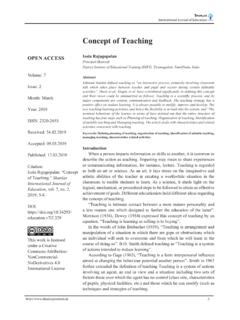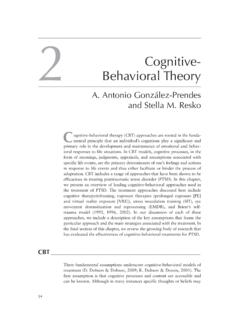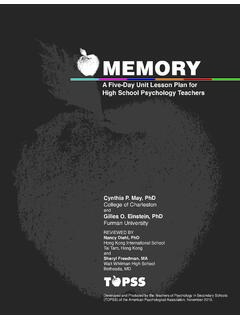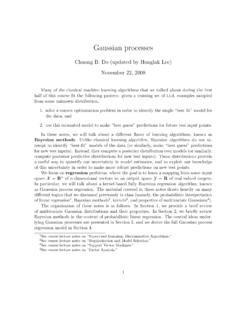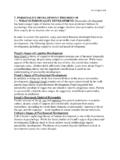Transcription of LEARNING AND TEACHING : THEORIES, APPROACHES …
1 LEARNING AND TEACHING : theories , APPROACHES AND MODELS 19 CHAPTER 2: BEHAVIORIST APPROACH Prof. Dr. Hasan Bacanl skudar University, Faculty of Humanities and Social Sciences (Translated by Sakine Koca Sincer) Behaviorist Approach First of all, behaviour is composed of reactions and movements that an organism gives and does in a certain situation. The term, behaviour is mostly used for actions that can be observed from outside. Behaviorist LEARNING approach mostly focuses on how behaviours are acquired. Behaviorist approach claims that LEARNING can develop by means of establishing a connection between stimulus and behaviour, and that any behaviour can be changed through reinforcement. Behaviorists address LEARNING as a mechanic process and give particular importance to objectivity. According to behaviorists, people are not good or bad from birth.
2 Experiences and environment constitute a human s personality. According to them, human brain can be compared to a black box. Neither can we know what is going on in this black box nor do we need to know it. What is important is not what is happening in this black box, but what is important is what goes in this black box (input) and what comes out of it (output). Outputs are objective, observable and measurable. Inputs and outputs can be adjusted, arranged and controlled. What is important is not the senses of a person, but the reflection of The pioneers of behaviorist approach are I. Pavlov, Watson, Thorndike, Guthrie and Skinner. History of Behaviorist Approach By the early 20th century, the science of psychology has had important turnouts, 20-30 years after Wundt established the first psychology laboratory. Of all these turnouts, the method of introspection is the leading one.
3 Wundt and his followers thought that the subjects such as conscious and feelings expected to be studied by psychology, could be studied just by introspection and they didn t consider it risky to use introspection as a scientific method. Psychology can use introspection as a scientific method since it deals with inner lives of people just as sciences about outer world use external observation as a scientific method. However, many have considered objectivity and reliability of introspection as a real problem. Another development in those years occurred in the world of science. Physical sciences made a great progress in those years and especially physics changed the world of science fully. Moreover, the philosophical tradition behind physics constituted the base of people s questioning most of the things. Another development in the early 20th century was that functionalism was on the rise within the scope of psychology.
4 Some phenomena such as conscious, which were accepted to be a structure before started to be accepted as a process helping to adapt to the environment. Doubtless to say, Darwin s evolutionary theory also influenced this idea. Darwin s ideas about living beings that had to adapt to the environment in which they were living also made tremendous impact on psychology. Another development that can be evaluated in this context is the study of animal psychology. Animals psychological situations turned into a research subject under the influence of Darwin. It was thought that animals had some qualities such as conscious as well as perception, distinguishing. An article (psychology through the eyes of behaviorist) written by John Broadus Watson in 1913 in such a positivist environment was revolutionary. In his article, which changed both the methods and subjects of psychology, Watson stated that it was not scientific for psychologists to deal with unobservable phenomena such as conscious or thought, and that science had to deal with observable behaviours.
5 Doubtless to say, Watson s these ideas have a background, in other words, Watson did not suddenly felt it necessary to boom like this. Watson could evaluate the spirit of time well and could read the developments well. Although some other important names of behaviorist approach LEARNING AND TEACHING : theories , APPROACHES AND MODELS 20 such as Thorndike and Pavlov displayed some manners that could be included in behaviorist APPROACHES before, Watson s article is accepted as the birth of behaviorist approach. The period that started with Watson s article is called as Watson s behaviorism and it is accepted to last until 1930. The second phase, which comprises the studies of Edward Tolman, Edwin Guthrie, Clark Hull and Skinner, is called as new-behaviorism and it lasted until 1960s. In this period, behaviorists claimed that (a) the base of psychology was composed of studies about LEARNING , (b) behaviours could be explained by principles of conditioning and (c) psychology had to comply with the principle of functionalism and that a concept that could not be defined functionally could not studied, either.
6 The third phase is the period that has been lasting since 1960 and it is called as new-new-behaviorism or social behaviorism. The pioneers of this phase are Albert Bandura and Julian Rotter. Cognitive elements were added to behaviorism in this period. Behaviorists of this period think that it is not true for behaviorism to deny mental and cognitive processes. Even Bandura named his theory social-behaviorism first and then replaced this name with social-cognitive theory while Rotter called his theory social LEARNING theory. To have a general look at behaviorists, there are two kinds of behaviorists: methodological behaviorist and radical behaviorist. While Bandura and Rotter are included in the group of methodological behaviorist, Watson and Skinner are included in the group of radical behaviorist. While radical behaviorists believe that psychology should study just the observable behaviours and environmental processes, methodological behaviorists think that cognitive processes can also be studied, but methods of behaviorist approach should be used.
7 (Schultz and Schultz, 2007). According to another classification, there are three types of behaviorism: methodological behaviorism claiming that psychology is the science of behaviour, not mind; psychological behaviorism claiming that the reason of behaviour is not internal (such as mental processes) but external and analytical (philosophical or logical) behaviorism claiming that mental concepts and processes can be defined in terms of behaviorism. This variety also signifies that behaviorist approach includes different ideas. On the other hand, when we come to today, behaviorism not only has lost strength but also seems to be defeated by cognitive revolution. Put strict behaviorists such as Watson, Pavlov and Skinner aside, new-new behaviorists state that they are cognitive-behaviorists. Even, according to a research, two thirds of the members of American Behaviour Analysis Association established depending on behaviorist approach define themselves as cognitive-behaviorist.
8 Fundamentals of Behaviorist Approach As is mentioned above, behaviorism has passed through three phases. It is clear that different ideas have been accepted in each of these phases. However, behaviorism is basically an approach founded by Watson and it is doubtless that it has got some fundamental qualities. These fundamental qualities have been influenced by the conditions of that day. The first behaviorists who tried to gain scientific qualities to psychology were influenced by physics to a great extent and even they imitated them (Ormrod, 1990): 1. A person s LEARNING is similar to other living things learnings. The same principles are valid about a person s LEARNING in the same way a dog learns. So, behaviorists use the term, organism in their definitions and the term, organism comprises both people and animals. 2. Depending on the first principle, behaviorists try to explain human behaviour by means of the studies carried out with animals.
9 Of course, there are a lot of reasons (such as being reinforced and raised easily), but the most important reason is explained by Tolman in that way: Let s watch what mice live in cages, these animals cannot go out at night while a researcher plans to carry out an experiment.. They also don t have a conflict of class or race and they avoid politics, economics and psychological notices. In short, it seems quite possible to isolate variables well while doing experiment with animals. Even Pavlov built a special building in which he thought he could control all kinds of physical stimuli. LEARNING AND TEACHING : theories , APPROACHES AND MODELS 21 3. Like John Locke s understanding of human mind, human is like a blank sheet from birth. The environment shapes it. (Mind is not a term used by most of the behaviorists.) 4. LEARNING can be examined by means of focusing on measurable and observable events such as physical subjects.
10 5. Most behaviorists believe that people s qualities such as feeling, idea, motivation cannot be observed or measured directly and so they cannot be handled and studied scientifically. Organism is a black box. What goes in (stimulus) and what comes from (reaction) the box is measurable and observable. However, what is going on in the box cannot be understood. So, it is not included in the subjects of psychology. 6. Principles of LEARNING are based on the connection between stimulus and reaction. 7. Behaviorists use the term of conditioning rather than LEARNING . According to this, organism is conditioned (to give a certain reaction) by environmental stimuli in LEARNING . So, such kind of LEARNING takes place out of the control of the organism. 8. LEARNING is said to take place only when there is a change in one of the observable behaviours of the organism.




